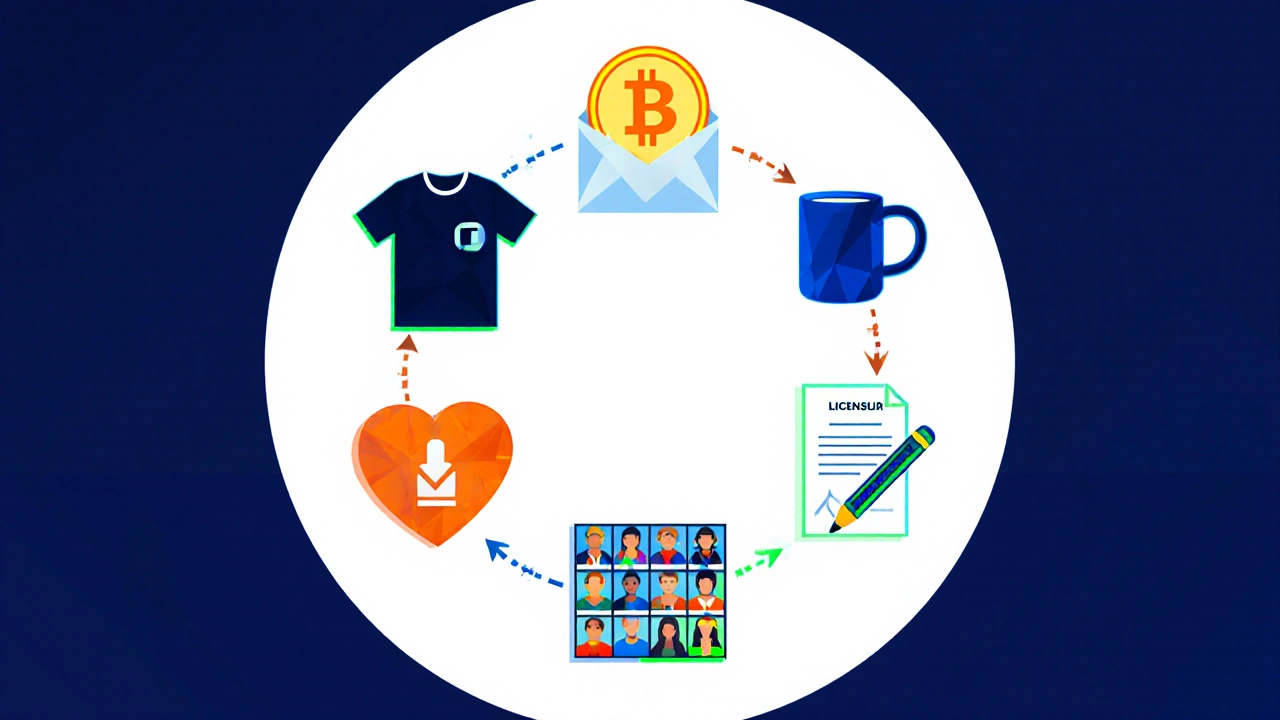Digital Art Income Calculator
Enter your numbers and click "Calculate Monthly Income" to see your projected earnings.
When you hear digital art is a visual creation produced using software, tablets, or computer graphics tools, the first thought is often about colors and aesthetics. But the real question many creators ask is: can it actually pay the bills? The short answer is yes-if you pick the right channels, price wisely, and treat your craft like a small business.
TL;DR - Quick Takeaways
- Multiple revenue streams exist: NFTs, prints, commissions, stock sites, subscriptions.
- Start with low‑effort platforms (print‑on‑demand, stock) to build cash flow.
- Scale to high‑margin options (direct commissions, licensing) once you have an audience.
- Consistent branding and social media presence boost sales across all channels.
- Track expenses, taxes, and time to keep your art business profitable.
Understanding the Main Money Makers
Before you jump in, it helps to see the landscape as a set of distinct but often overlapping income sources. Below are the six most common ways digital artists generate profit today.
- Print‑on‑Demand (POD) is a service that prints your artwork on merchandise only after a customer orders it. No inventory, no upfront cost.
- Non‑Fungible Tokens (NFTs) are unique blockchain‑registered digital assets that can be bought, sold, or traded. They often include royalty clauses.
- Commission Work is custom art created for a client based on their specifications. Direct pricing and high margins.
- Stock Art Marketplaces are online libraries where buyers license images for commercial use. Volume‑driven earnings.
- Patreon & Subscription Models let fans pay a recurring fee for exclusive content, behind‑the‑scenes looks, or early releases.
- Licensing & Merchandising involves selling the rights to reproduce your art on products, books, or media.
Comparing Revenue Channels
| Channel | Typical Earnings (USD) | Effort Required | Platform Examples | Risk Level |
|---|---|---|---|---|
| Print‑on‑Demand | $0.5‑$5 per sale | Low - upload, set price | Redbubble, Society6, Teespring | Low |
| NFTs | $50‑$5,000 per drop | Medium - mint, market | OpenSea, Foundation, Rarible | Medium‑High (market volatility) |
| Commissions | $100‑$2,000 per piece | High - client communication, revisions | Fiverr, ArtStation, Direct | Medium (client disputes) |
| Stock Marketplaces | $1‑$20 per download | Low‑Medium - tag, upload | Shutterstock, Adobe Stock, iStock | Low |
| Patreon | $5‑$500 per month per patron | Medium - regular content | Patreon, Ko‑fi | Low‑Medium (churn) |
| Licensing | $100‑$10,000 per contract | Medium‑High - legal paperwork | Direct outreach, ArtLicensing agencies | Medium |
Step‑by‑Step: Turning Your Digital Art into Cash
- Choose Your Core Platforms - Start with one POD service and one stock site. Set up accounts, add your best pieces, and write SEO‑friendly titles.
- Build a Portfolio Hub - Use a simple website or a free platform like Behance to showcase all channels in one place. Include clear contact info.
- Price Smartly - Research what similar creators charge. For POD, add 30‑40% markup; for commissions, base rates on skill level and time.
- Promote on Social Media - Post process videos on TikTok, share finished works on Instagram, and engage with art hashtags. Convert followers into buyers by linking to your store.
- Experiment with Limited Drops - Release a small batch of NFT art or a themed print series. Scarcity often drives higher perceived value.
- Collect Data - Track sales per platform, average order value, and time spent. Use a spreadsheet or free accounting app to see which channel yields the best ROI.
- Scale What Works - If prints sell consistently, expand the product range. If commissions are steady, raise your rates or bundle services.

Marketing Tips That Actually Move the Needle
Even the best artwork stays invisible without a plan. Here are proven tactics that digital artists use to attract paying customers.
- Storytelling: Share the inspiration behind each piece. People pay more for a narrative than for a pretty picture.
- Email List: Capture emails with a free wallpaper download. Send monthly updates with new releases or exclusive discounts.
- Collaborations: Pair with musicians, game developers, or other visual creators. Cross‑promotion opens new audiences.
- Live Streams: Host a 30‑minute drawing session on YouTube or Twitch. Viewers can tip or buy the finished work instantly.
- SEO for Image Search: Name files with descriptive keywords (e.g., "cyberpunk‑city‑digital‑painting.jpg"), add alt text, and write concise captions.
Avoiding Common Pitfalls
Many artists quit early because they hit a snag they didn’t expect. Spot these red flags before they cost you time or money.
- Undervaluing Work - Pricing too low signals low quality and makes it hard to raise rates later.
- Ignoring Taxes - In Canada, art income is taxable. Keep receipts and consider quarterly installments to avoid surprises.
- Platform Fees - Some POD sites take up to 30% of your margin. Factor fees into pricing or negotiate higher royalties on NFT marketplaces.
- Burnout - Treat your studio like a business: set work hours, take breaks, and schedule “non‑selling” creative time.
- Copy‑cat Content - Originality matters especially for NFTs. Ensure your work doesn’t infringe existing copyrights.
Real‑World Example: From Hobbyist to Six‑Figure Earner
Meet Maya, a self‑taught illustrator from Toronto. In 2021 she started uploading fantasy sketches to a POD site, earning $150 a month. By 2022 she added a small NFT series, netting $2,200 in the first drop. She then opened a Patreon at $10 per month, gaining 120 patrons in six months. Today, Maya’s combined monthly revenue exceeds $5,000, and she’s negotiating a licensing deal with a tabletop game publisher. Her secret? Consistent weekly uploads, cross‑posting all sales links, and using a simple spreadsheet to monitor ROI.
Next Steps: Your First Money‑Making Action Plan
- Pick two platforms: one POD (e.g., Redbubble) and one stock site (e.g., Adobe Stock).
- Upload 5 of your strongest pieces with SEO‑friendly titles.
- Create an Instagram highlight titled "Shop" linking to your store.
- Set a 30‑day sales goal (e.g., $100) and track daily.
Hit those milestones, then revisit the table above to decide where to invest next - maybe a small NFT experiment or a commission outreach email.
Frequently Asked Questions
Can I make a full‑time income from digital art?
Yes, many creators earn six figures by combining several streams-prints, commissions, NFTs, and subscriptions. Success depends on audience size, pricing, and consistent marketing.
Do I need a separate website for each platform?
No. A single portfolio site (Behance, ArtStation, or a simple WordPress page) can link to all your sales pages. Centralizing your brand makes it easier for buyers to find you.
How much should I charge for a custom illustration?
Start with a baseline of $100-$150 for a 1‑hour piece, then add $50 for each additional hour or complexity factor (characters, background detail). Always include a contract that outlines revisions and usage rights.
Are NFTs still profitable in 2025?
They can be, but the market has cooled. Success now hinges on strong community engagement and limited, high‑quality drops rather than flooding the marketplace.
What taxes do I need to consider as a Canadian digital artist?
Art income is taxable under Canadian law. Keep records of all revenue, platform fees, and business expenses. You may be eligible for the Home Office deduction if you work from a dedicated space.







